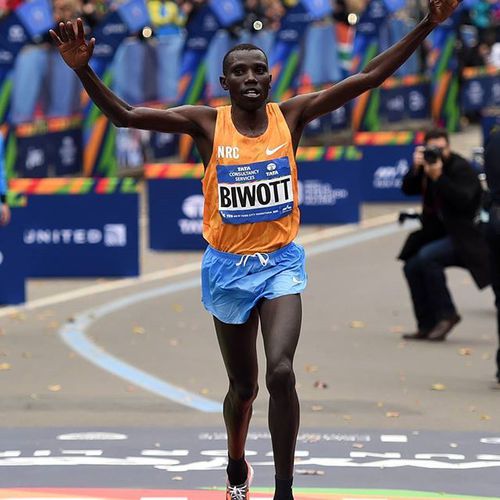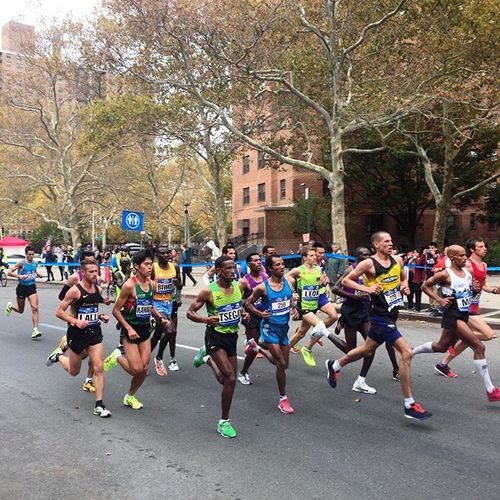 Foto: Timothy Clary/AFP, from Instagram by Jornada
Foto: Timothy Clary/AFP, from Instagram by Jornada
After developing a reputation for being an athlete with talent, but one who resided in the patina of top marathon runners, Stanley Biwott brought himself into the top seats with his gutty, determined and masterful win in the city that never sleeps, New York City today.
In yet the second of three World Marathon Major races this fall that no longer use pace makers, the race developed organically, giving the viewer a chance to have a cup of coffee and see many more of the athletes than one normally sees in such a prestigious race.
There was a strong story for Americans this year as well.
Meb Keflezighi continous to astound, adding a new American masters and New York City Masters course records with his fine seventh place. Craig Leon ran what was the best tactical race of his career, if it was not a personal best, with his eighth place.
But, when the pace got hot, late in the race, Stanley Biwott, Geoffrey Kamworor, Lelisa Desisa and Wilson Kipsang were there! With a 4:41 mile from Kipsang in mile 19, the field was down to four.
And then, the racing really began….
The New York City Marathon in 2015 will be remembered as a battle royale over the last seven miles, with it coming down, as it always does to two very determined athletes.
The early pace was pretty relaxed, as the pack hit the 5k in 15:42 and 10k in 31:31. A pack from 18-30 remained at this time. Toni Reavis called them, quite correctly, as “interlopers”. Some runners who could run relatively fast, but when the going got tough, they would fall off the pace, finishing way down the food chain.
 the lead pack, Instagram photo (via Scribble) by Ted Janger
the lead pack, Instagram photo (via Scribble) by Ted Janger
Running a 5:06 pace for the first half marathon, which was passed in 1:06:49, is a rarified talent. About thirty of the 50,000 in this race, could handle said pace. That thirty dropped to sixteen, then to eight around 20k.
Wilson Kipsang, the defending champion was there. Lelisa Desisa, the 2014 second place finisher was there. Meb Keflezighi, Nick Arciniaga and Craig Leon were the top American males. Geoffrey Kamworor, the man who battled Mo Farah over 9,900 meters in the World Champs 10,000 meters, was there.
Juan Luis Barrios, the top Mexican runner from 1,500 meters to the marathon, was here, hoping to channel Rodolfo Gomez, who placed as high as second here in the magical years of the early 1980s, when the US battled Mexico for marathon domination.
Yuki Kawauchi, a top Japanese marathoner, was also up there.
Again the pace, was, well, less than daunting. The first mile of any real note was mile 12, run in 4:47, which broke up the “interlopers.”
The half was hit in 1:06:49, and the 25k in 1:19:38, with the 5k in 16:24. This was faster than top race walkers, but not much faster.
While the pace was pedestrian like, the tactics were interesting. Meb Keflezighi told us afterwards: ” it was great to see Nick and Craig there, and be with my fellow Americans. There was definitely a lot of team work with the Ethiopians and Kenyans…obviously we were waiting.”
Wilson Kipsang looked ill at ease at this early pace, much like he looked in Beijing. At that point, I wondered if he had recovered from the heat of Beijing. Kipsang covered all of the moves, as did Kamworor, Stanley Biwott and Leslisa Desisa, but something was just a bit off.
Our friends at Marathonguide.com noted on their live blog that “Tyler McCandless, noted that this was a race he could run in.”
In fact, right after 25k, Craig Leon and Meb Keflezighi lead the race for a bit. Miles 16 to 18 were run at 2:14 pace as no one would lead, no one would push, all were waiting.
Mile 19 got it going, and the 4:40 mile there put the pack down to eight.
20 miles was hit in 1:42:01 after mile 19 being hit in 1:36:47. This was a 2:14 pace! Could this continue?
Obviously, when Geoffrey Kamworor ran 4:24 for mile 21, there would be a reaction. And there was, five dropped off, with defending champion Wilson Kipsang being the last to go. Kipsang was nine seconds adrift after mile 22 was seen in 1:50:44, Kamworor and Biwott threw in a 4:31 and a 4:33. That means that Kamworor dropped an 8:55 two mile between miles 21 an 23. Remember that it was Paavo Nurmi, who, around 1930 was the first man to break nine minutes for two miles in a race of that distance!
Coach Patrick Sang, who oversees Kamworor, told me” if it had been a 4:27, or a 4:29, the race would have been different.”
Geoffrey Kamworor had run himself ragged. By mile 23, hit in 2:00:12, Lelisa Desisa is in third, fifteen seconds back.
The two players, namely Stanley Biwott and Geoffrey Kamworor, are battling each other.
Just to remind you, the miles were 4:24, 4:31, 4:33, 4:44 and then, 4:35. Just around twenty-five miles, Stanley Biwott opens some yardage, namely five seconds.
Kamworor fights valiantly, he brings it back to four, but then no more. Stanley Biwott, who had been a bridesmaid too many times for his comfort in his marathons, kept the pressure on.
On the large screen TV at twenty five plus miles, Biwott looked back at nearly the same time Kamworor was looking behind. I figured that both guys were gutted, and that was all she wrote.
It is one thing to run the last miles of a marathon, which some incoherent folks have suggested in like childbirth. The last two miles of a marathon are tough, but it is not, as one thoughtful women friend noted, is nothing like having a nine pound bowling ball drop out of one’s body.
I have digressed.
My point was, in the pain of running a marathon, having to keep your head together and sprint like mad to keep a position or gain a position is the marathoners’ nightmere.
Biwott and Kamworor were in that nightmere.
In the end, Stanley Biwott held on to win his first marathon major, in 2:10:34. Geoffrey Kamworor ran 2:10:47, for second. Lelisa Desisa was third in 2:12:10.
Afterwards, the pressers were a bit subdued. Stanley Biwott was asked how to explain his performance improvements. He had finished numero deux in London, numero quatre in London and numero cinq in New York.
Stanley Biwott gave a plausible explanation: ” During my previous Marathons, I had not been able to run the last 5 kilometers. So, for my preparation I trained for the 42 kilometers, not 35 kilometers. So, I was able to do my endurance speed to finish with a strong speed without slowing at the end.”
Kamworor was more succinct. ” I am looking foward in the future, maybe next year, I will come back again and work hard to win a New York Marathon.”
2015 TCS New York City Marathon, Men, 1. Stanley Biwott, KEN, 2:10:34, 2. Geoffrey Kamworor, KEN, 2:10:48, 3. Lelisa Desisa, ETH, 2:12:10, 4. Wilson Kipsang, KEN, 2:12:45, 5. Tsegay Yemane, ETH, 2:13:24, 6. Yuki Kawauchi, JPN, 2:13:29, 7. Meb Keflezighi, USA, 2:13:32 (masters course record, breaks John Campbells 2:14:41, 1991, also US record broken of 2:13:52), 8. Craig Leon, USA, 2:15:16, 9. Birhanu Dare Kemai, ETH, 2:15:40, 10. Kevin Chelimo, KEN, 2:15:49, 11. Andrea Lalli, Italy, 2:17:12, 12. Juan Luis Barrios, MEX, 2:18:06, 13. Negash Abebe Duki, ETH, 2:20:30, 14, Nicholas Arciniaga, USA, 2:22:07, 15. Carmine Buccilli, ITA, 2:23:48, ‪#‎tcsnycmarathon‬
Author

Larry Eder has had a 52-year involvement in the sport of athletics. Larry has experienced the sport as an athlete, coach, magazine publisher, and now, journalist and blogger. His first article, on Don Bowden, America's first sub-4 minute miler, was published in RW in 1983. Larry has published several magazines on athletics, from American Athletics to the U.S. version of Spikes magazine. He currently manages the content and marketing development of the RunningNetwork, The Shoe Addicts, and RunBlogRun. Of RunBlogRun, his daily pilgrimage with the sport, Larry says: "I have to admit, I love traveling to far away meets, writing about the sport I love, and the athletes I respect, for my readers at runblogrun.com, the most of anything I have ever done, except, maybe running itself." Also does some updates for BBC Sports at key events, which he truly enjoys. Theme song: Greg Allman, " I'm no Angel."
View all posts




















